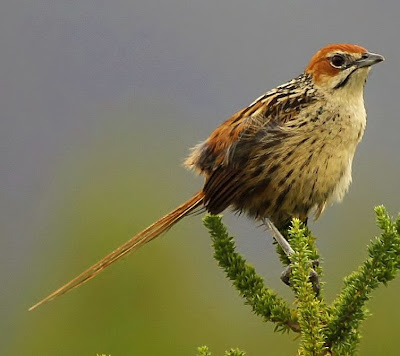Sphenoeacus afer
 |
| Photo by Carmelo López (Internet Bird Collection) |
Common name:
Cape grass-warbler (en); felosa-do-Cabo (pt); sphénoèque du Cap (fr); yerbera de El Cabo (es); Kapgrassänger (de)
Taxonomy:
Order Passeriformes
Family Sylviidae
Range:
This species is found in southern eastern and north-eastern South Africa and also along the border between Zimbabwe and Mozambique.
Size:
These birds are 17-19 cm long and weigh 30 g.
Habitat:
The Cape grass-warbler is mostly found in high-altitude grasslands, but also uses fynbos scrublands and the edges of mountain forests.
Diet:
They forage mostly on the ground beneath vegetation, taking insects such as beetles, grasshoppers and caterpillars.
Breeding:
Cape grass-warblers breed in July-April, varying between different parts of their range. The nest is built by the female, consisting of a bowl made of twigs, grass blades and leaves, and lined with finer plant material. It is typically concealed near the ground in a tussock of grass or in some tangled vegetation. The female lays 2-3 eggs, which she incubates alone for 14-8 days. The chicks are fed by both parents and fledge 14-16 days after hatching.
Conservation:
IUCN status - LC (Least Concern)
This species has a large breeding range and is described as locally common. The population is suspected to be in decline owing to ongoing habitat destruction, but it is not considered threatened at present.
No comments:
Post a Comment